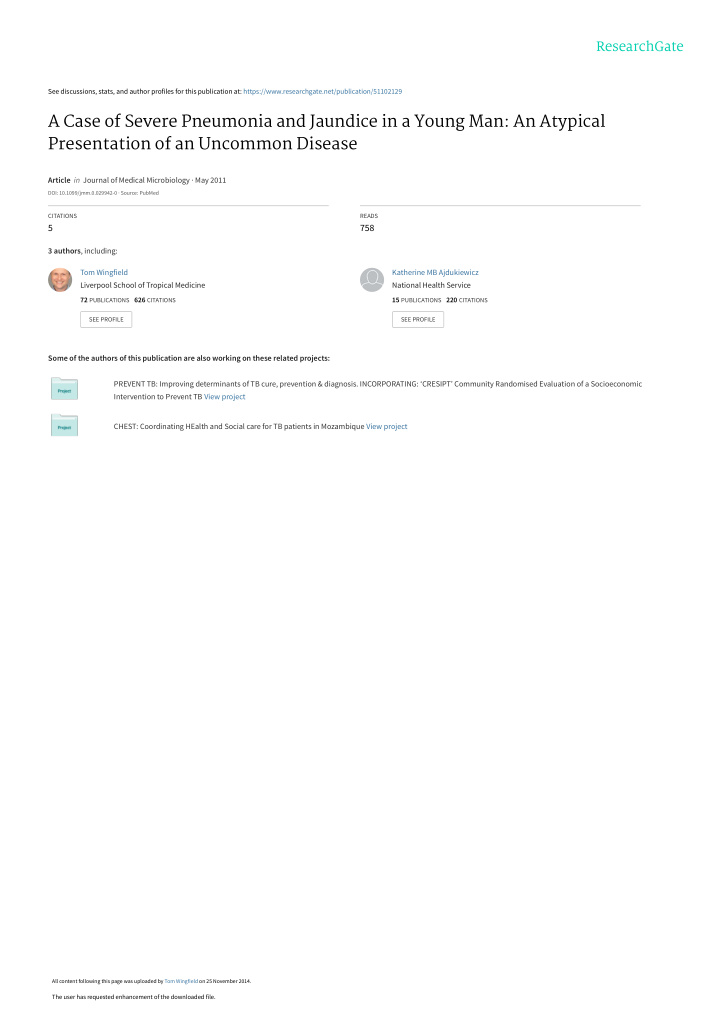



See discussions, stats, and author profiles for this publication at: https://www.researchgate.net/publication/51102129 A Case of Severe Pneumonia and Jaundice in a Young Man: An Atypical Presentation of an Uncommon Disease Article in Journal of Medical Microbiology · May 2011 DOI: 10.1099/jmm.0.029942-0 · Source: PubMed CITATIONS READS 5 758 3 authors , including: Tom Wingfield Katherine MB Ajdukiewicz Liverpool School of Tropical Medicine National Health Service 72 PUBLICATIONS 626 CITATIONS 15 PUBLICATIONS 220 CITATIONS SEE PROFILE SEE PROFILE Some of the authors of this publication are also working on these related projects: PREVENT TB: Improving determinants of TB cure, prevention & diagnosis. INCORPORATING: ‘CRESIPT’ Community Randomised Evaluation of a Socioeconomic Intervention to Prevent TB View project CHEST: Coordinating HEalth and Social care for TB patients in Mozambique View project All content following this page was uploaded by Tom Wingfield on 25 November 2014. The user has requested enhancement of the downloaded file.
Journal of Medical Microbiology (2011), 60, 1391–1394 DOI 10.1099/jmm.0.029942-0 Severe pneumonia and jaundice in a young man: an Case Report atypical presentation of an uncommon disease T. Wingfield, T. J. Blanchard and K. M. B. Ajdukiewicz Correspondence The Monsall Unit, Department of Infectious Diseases and Tropical Medicine, North Manchester T. Wingfield General Hospital, Manchester, UK tomwingfield@hotmail.co.uk We present a patient with an atypical presentation of Fusobacterium infection, the genus responsible for Lemierre’s syndrome. This syndrome, which often affects healthy, young people and can be fatal if not recognized and treated early, is defined as a history of recent oropharyngeal infection with clinical or radiological evidence of internal jugular vein thrombosis and isolation of anaerobic pathogens, mainly Fusobacterium necrophorum . The history, presentation, investigations and management of the patient are described and then contrasted with the existing Received 9 January 2011 Accepted 29 April 2011 literature surrounding Lemierre’s syndrome, once termed the ‘forgotten disease’. Case report The following day, the patient continued to be pyrexial, his oxygen requirements increased and he was referred to the A previously fit and well 26-year-old male presented to Infectious Diseases team. On review, he had a PaO 2 of 10.14 hospital with a 3-day history of severe sore throat, general kPa on 35 % FiO 2 with normal PCO 2 and pH, indicating type malaise, non-bloody diarrhoea, vomiting, fever and head- 1 respiratory failure with a wide arterial–alveolar gradient. ache. He had no significant past medical history, did not Temperature was 40 u C and he remained tachycardic at 140 take any medications and had no known allergies. He was an beats min 2 1 . He was noted to have pain in the right side of electric engineer who worked with air conditioning units the neck with ipsilateral swelling on examination. Legionella and was an occasional drinker, a non-smoker and lived with and pneumococcal urinary antigen were negative. Renal his fiance ´, their two children and a dog. He had no history of function was improving but leukocytes and C-reactive foreign travel and no risk factors for blood-borne viruses. protein remained raised. It was felt that the patient was On initial examination, the patient was clammy and febrile septic with multi-organ involvement, and a diagnosis of with jaundiced sclera. He had pharyngeal erythema and Lemierre’s syndrome was considered. Co-amoxiclav was decreased air entry in the right lung base. Heart sounds changed to tazocin (tazobactam and piperacillin) intrave- were normal. He was tachycardic at 150 beats min 2 1 but nously, and prophylactic enoxaparin was commenced. normotensive. He was tender in the right upper quadrant Clarithromycin was continued. An arterial line was inserted and right lower quadrant with a 3 finger breadth palpable and PaO 2 was 19.6 kPa on 60 % FiO 2 , indicating a further smooth liver edge. Neurological examination was normal. widening of the arterial–alveolar gradient. The patient was counselled for blood-borne virus screen including HIV. He Initial blood tests revealed acute kidney injury with an was moved to a high dependency unit, and although imaging estimated glomerular filtration rate of 32 ml min 2 1 , crea- investigations for endovascular thrombosis and liver/pulmo- tinine 207 m mol l 2 1 , urea 13.8 mmol l 2 1 and bicarbonate of nary abscesses were entertained, he was considered too 19 mmol l 2 1 . Leukocytes were raised with a neutrophilia unstable to move to the radiology department. and C-reactive protein was 258 mg l 2 1 . Haemoglobin was 14.9 g dl 2 1 , platelets 79 6 10 9 l 2 1 and international normal- On day 3 of admission, a repeat chest radiograph showed that consolidation now involved the right mid and lower zone. ized ratio 1.2. He had deranged liver function tests with a bilirubin level of 91 m mol l 2 1 , alanine aminotransferase 50 U l 2 1 , Inflammatory markers, leukocytes and renal function were albumin 35 g l 2 1 and alkaline phosphatase of 128 U l 2 1 . Glucose improving but O 2 requirements remained high. The patient had a high bilirubin, low platelets and a drop in haemoglobin was normal and blood cultures were sent. A chest radiograph to 11.2 g dl 2 1 . Blood film showed thrombocytopenia with showed patchy linear opacities in the right lower zone. An large platelets and reactive neutrophil leucocytosis, but no electrocardiogram showed sinus tachycardia. polychromasia, spherocytes or fragmentation. The initial diagnosis was community-acquired pneumonia. Oxygen requirements stabilized over the following 3 days. He was admitted under the medical team and treatment On day 4, a Gram-negative rod was seen in the anaerobic with intravenous fluids, co-amoxiclav and clarithromycin blood culture and metronidazole was added to the was initiated. antibiotic regimen. Cultures grew two anaerobic colonies of differing morphology so further purity plates were Abbreviation: IJV, internal jugular vein. 029942 G 2011 SGM 1391 Printed in Great Britain
Recommend
More recommend